Nutrition during competition poses the greatest challenge for athletes. Because here applies:
Practice makes perfect
. To maintain optimal performance, carbohydrates, fluids & electrolytes must be supplied during efforts lasting over 90 minutes. It is crucial to find the individual balance between optimal intake to maximize performance and gastrointestinal tolerance.
Carbs & Fluids: when and how much?
This is highly individual, but generally, no carbs and fluids can be supplied during swimming. Cycling, however, is the best time, as fluids and carbohydrates are most readily available here, and performance is least disturbed by intake. During running, significantly less can usually be supplied, as tolerance and food intake are often more difficult. More precise details on timing and quantities will follow in the next sections.
Energy Supply
As already mentioned, our carbohydrate stores in the muscles are only sufficient to optimally supply us with energy for approximately 75-90 minutes of exercise. For longer durations of exertion, it is therefore necessary to supply the body with additional carbohydrates to spare our glycogen stores, prevent hypoglycemia & central nervous system fatigue, and ultimately maintain performance (
1
). The amount and type of recommended carbohydrates depend on duration, intensity, and tolerance. Generally, once an amount of 60 g of carbohydrates per hour is exceeded, attention should be paid to a combination of glucose and fructose. This is because glucose and fructose are absorbed in the intestine via different transporters. Through this combination, in the correct ratio (approx. 2:1), total carbohydrate intake can be increased to over 90 g per hour (2, 3). However, it should be noted that excessive fructose intake can lead to gastrointestinal problems in some individuals. Therefore, it is important to test this method during training and gradually approach one’s own tolerance limit. 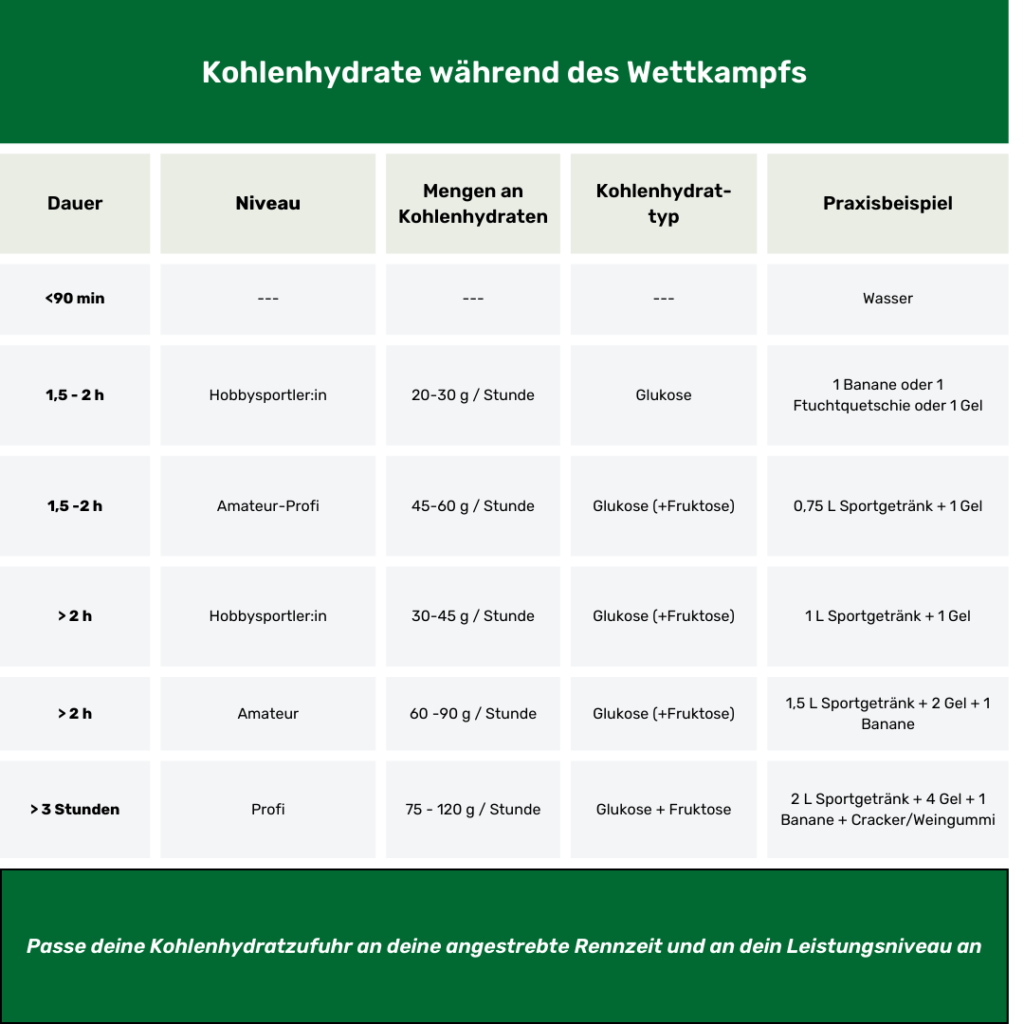
Sports drinks, gels, bars, or solid food – what is right for me?
Generally, carbohydrate intake can occur in both liquid and solid forms. However, the higher the carbohydrate intake, the more sensitive the gut reacts to solid food. With sports gels, bars, and solid food (banana, gummy bears, jam sandwich, pretzel sticks), fluid intake must be supplemented. Otherwise, gastrointestinal discomfort may occur. The fat content of bars varies greatly; a high fat content hinders digestion and can negatively impact performance. The carbohydrate concentration is significantly higher compared to a sports drink, which increases the likelihood of gastrointestinal problems. The advantage of sports gels lies in their ease of use. They require little space and are easy to store. Furthermore, one is largely independent of the organizer’s aid stations, as only fluids in the form of water need to be consumed. Ultimately, everyone must find out for themselves which carbohydrate sources are best tolerated during exertion and whether they suit their personal taste.
For a carbohydrate intake of 30 g per hour or more, we recommend using carbohydrates in liquid form
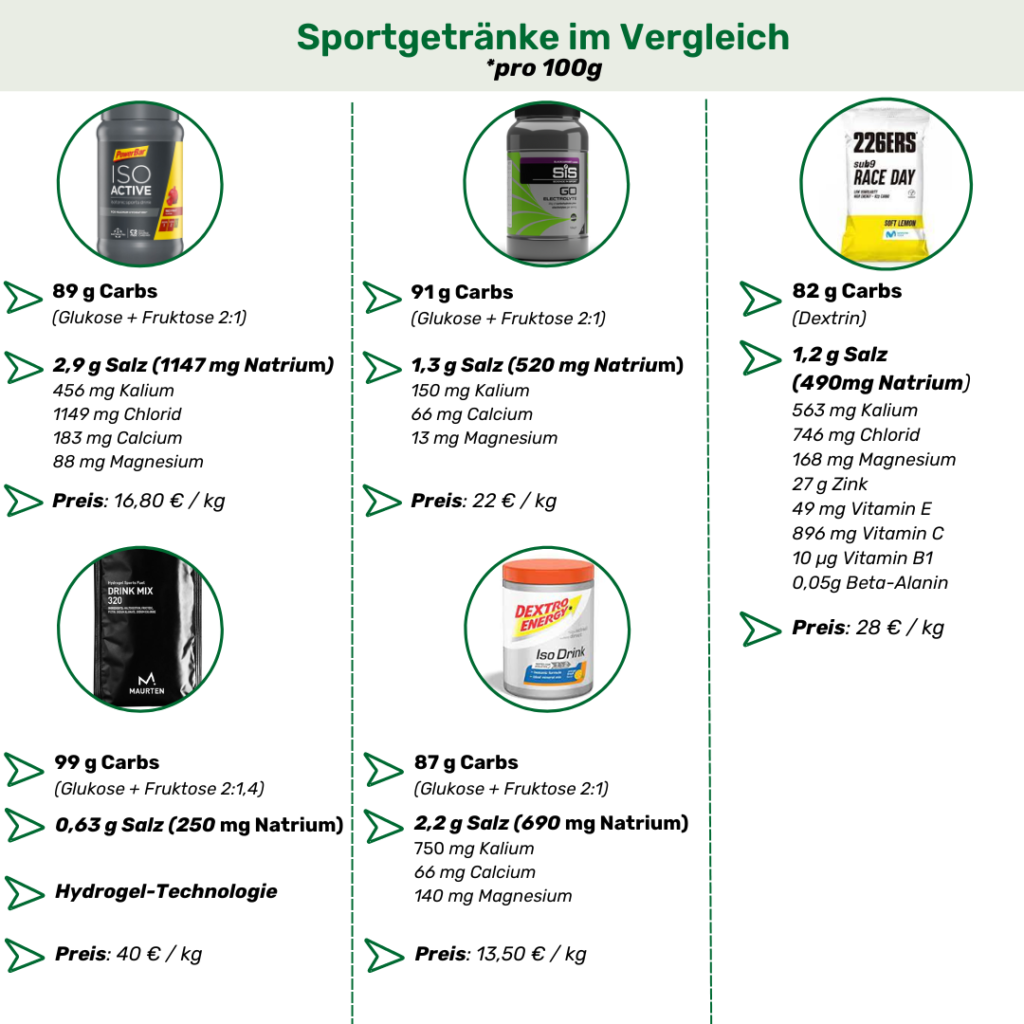
Organizer’s Aid Stations
The choice of intra-workout product should be made carefully and with a sufficient testing phase. Our recommendation: Find out beforehand which carbohydrate products are offered at the aid stations on site and test them during training. Alternatively, you can use your own sports drink on the bike throughout, and additionally consume only fluids in the form of water and carbohydrates in the form of gels.
How to Mix your Own Sports Drink
Sports drinks contain 6-8% carbohydrates and 400-1100 mg sodium/L. Here are 2 ways you can mix your own sports drink.
- 500 ml water + 500 ml fruit juice (e.g., mild apple juice, cranberry) + approx. ½ tbsp sugar + 1 pinch of salt
- 1000 ml fruit tea (cooled) + approx. 60g maltodextrin + 1 tsp sugar + 1-2 pinches of salt
*1g salt corresponds to 0.4g sodium!
Train your Tolerance
Yes, your gut is an adaptable organ and can be trained just like your muscles. For example, with a slow but continuously increased carbohydrate intake, the number of receptors in the gut increases, leading to more efficient absorption and fewer gastrointestinal complaints. Accordingly, energy and fluid intake during competition should be trained, otherwise discomfort is pre-programmed (4,5). These 6 training tips help you reduce gastrointestinal problems:
- Training with relatively large fluid volumes
- Training immediately after a meal
- Training with relatively high carbohydrate intake during exertion
- Intake of various carbohydrate sources during exertion (glucose & fructose)
- Simulation of race nutrition
- Generally increased carbohydrate intake in the diet
Fluid and Electrolyte Intake
The amount of fluids and electrolytes we need to consume during competition depends on how much we lose through sweating. Sweating helps regulate body temperature. However, sweat loss varies greatly individually and depends on various factors such as temperature, clothing, training status, acclimatization, intensity, and duration of exertion (
6
).
The goal is to avoid fluid loss of ≥2% (relative to body weight). However, this 2% refers to studies conducted at warm temperatures. At slightly cooler temperatures, reductions in endurance performance only occur from 3% onwards (
7
).
Calculate Sweat Rate
Fortunately, individual sweat loss is relatively easy to determine. It is sufficient to weigh yourself before and after exercise and to note down the amount of fluid consumed. 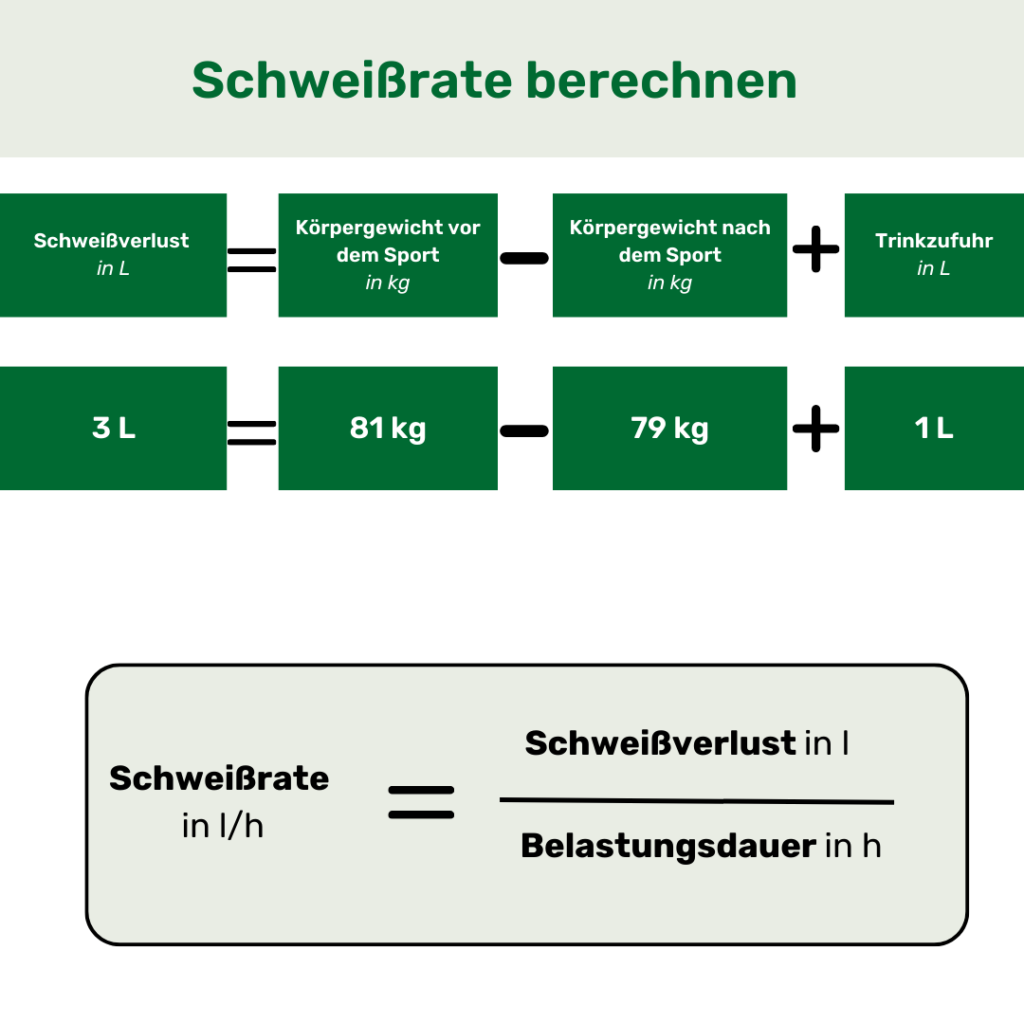
Example:
You weigh 81 kg before exercise, 79 kg afterwards, and drink 1 liter of fluid during it. Your exercise session lasts 2 hours, and you did not use the restroom. In total, we have a sweat loss of 3 liters. This corresponds to a fluid loss of 3.7% relative to body weight. However, since 1 liter was consumed, we have an actual weight loss of 2 kg (2.5%), meaning we must expect reductions in endurance performance.
- (3 kg / 81 kg) * 100 = 3.7%
- (2 kg / 81 kg) * 100 = 2.5%
To avoid these performance losses, fluid loss should be below 2% (1.6 kg weight loss). Your sweat loss is 1.5 liters per hour. Therefore, with your individual hydration strategy, you should drink at least 1.4 liters during your exercise session. That would be 0.7 L/h. So, 400 ml more than previously consumed.
If you use the restroom during your exercise session, the amount of urine should be subtracted from your sweat loss. If you do not record the amount of urine, you can estimate 0.4 L.
Electrolytes
With sweat, we primarily lose sodium as an electrolyte, which is why a sports drink should additionally contain sodium. While we also lose other electrolytes, such as magnesium or potassium, through sweat, it is in much lower concentrations. This does not negatively affect athletic performance. The slightly increased additional need for these electrolytes can easily be compensated for by a balanced diet – sodium is the exception, which should also be supplied during longer endurance exertions.
Remember: A sports drink should therefore primarily contain sodium as an electrolyte!
General Recommendation for Fluid and Electrolyte Intake (
8
)
- 400-1100 mg sodium/L
- 400-800 ml fluid per hour, divided into smaller portions every 15-30 minutes
- 6-8% carbohydrates
- Isotonic or slightly hypotonic drinks for rapid water absorption
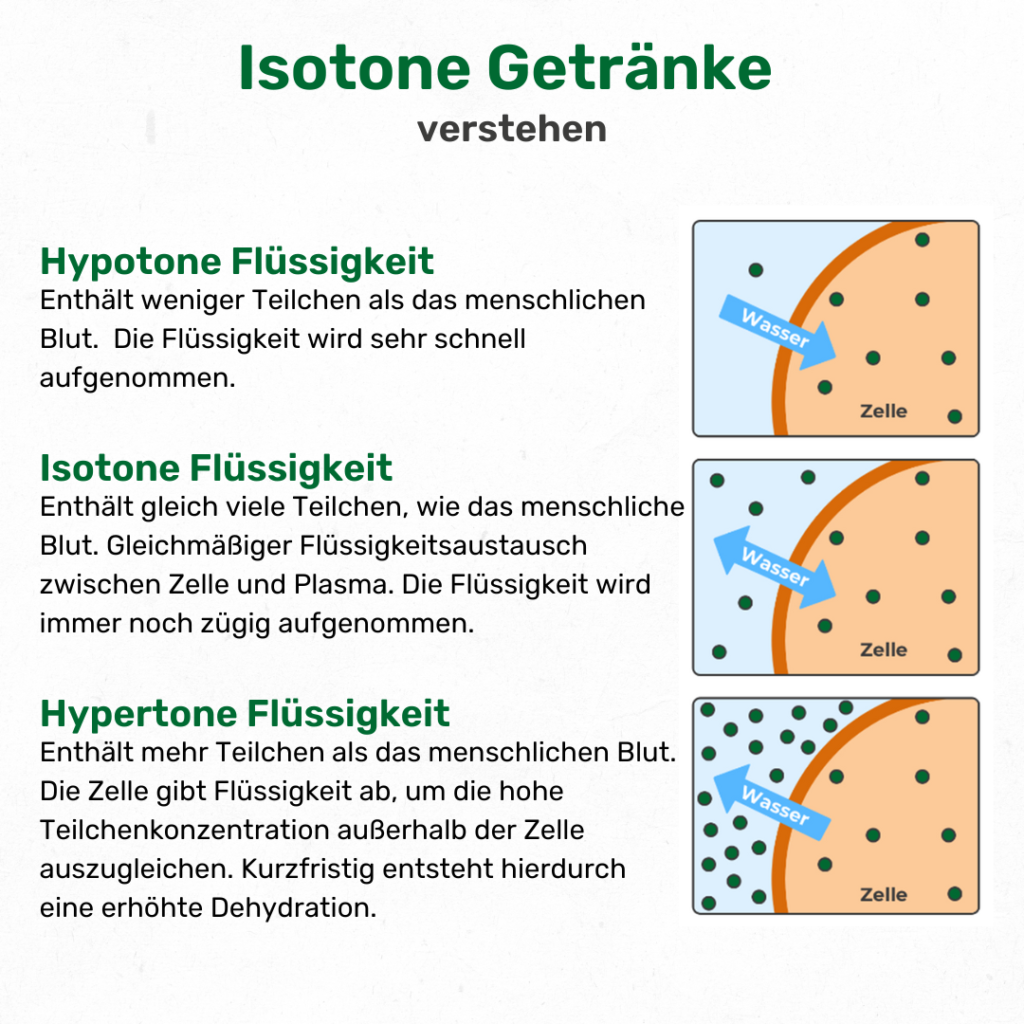
More is more?!
No, when it comes to water intake, that definitely does not apply. If we consume significantly too many low-sodium drinks and simultaneously exhibit high sodium loss through sweat (‘salty sweater’ – recognizable by salt stains on sportswear), this can lead to life-threatening water intoxication (also called hyponatremia). This primarily affects recreational athletes with long exertion times exceeding 4 hours. The symptoms are usually very similar to those of dehydration (disturbances of consciousness, weakness, fainting), which increases the risk of misdiagnosis (
9
)! To prevent this, it is all the more important to inform athletes about the potential dangers of excessive intake of sodium-free drinks!
An individual hydration strategy not only increases performance but also protects against life-threatening side effects!
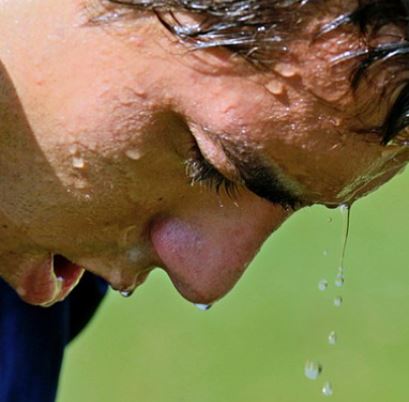
Relying on Thirst?
Some athletes feel less thirsty than others and therefore drink less. However, this does not mean that they meet their needs. From studies, we know that one cannot always rely on one’s own thirst sensation to maintain optimal fluid balance during exercise (
10
). This, in turn, shows how important it is to know individual sweat losses and thus supply the optimal amount of fluid. Taste can also significantly influence the amount consumed. Therefore, try different sports drinks to find your personal favorite!
A Plan is Important, BUT…
Having a plan, as you have already realized, is very important. But you should not stick to it at all costs. Be flexible and use your common sense to react to specific situations. If the weather changes and it gets much warmer than expected, you might need to drink more than planned. In case of gastrointestinal discomfort, it makes sense to temporarily reduce fluid and food intake.
Do not stick to your plan at all costs!
Post-Race Nutrition
You made it and successfully completed your competition! Now you can relax and celebrate. Reward yourself with a pizza, an ice cream, a cold beer, or whatever you fancy. Most importantly, make sure you eat something! Which foods you should eat is less important for the recreational athlete. If you want to maximize the shortening of the recovery phase after the strenuous race, the following nutrition tips will help you:
Immediately after the Race
The first thing you should do after crossing the finish line is to compensate for your fluid and electrolyte loss. Then you will quickly feel fit again. Your glycogen stores have also given their all and are depleted. Eat some pretzel sticks, crackers, fruit, or drink a cola / juice spritzer to immediately supply your body with some carbohydrates and electrolytes. Immediately after the race, your body is “primed” for nutrient absorption and can absorb them faster and more effectively! Solid food is often poorly tolerated after the race. Initially, opt for liquid alternatives.
Recovery Shake:
Prepare a recovery shake with 0.8g/kg body weight of carbs (e.g., in the form of maltodextrin) and 30-40g protein powder.
Ultimately, the most important thing is that you consume fluids, carbohydrates, and proteins, not the specific types or amounts!
A few Hours Later
After you have relaxed, acknowledged your performance, and perhaps are already on your way home, it is time for a wholesome meal that ideally contains all three macronutrients (carbohydrates, protein & fat). Especially after an intense triathlon competition, it is advisable to promote the recovery process by consuming antioxidant & anti-inflammatory foods. For severe muscle soreness, supplements such as cherry juice concentrate, omega-3 fatty acids, and ashwagandha can also be considered. A good basic diet with a high proportion of fruits and vegetables, as well as omega-3 fatty acids, is crucial in this phase (
11
,
12
,
13
,
14
).
Use these Foods to Support your Recovery Process:
- Berries
- Cherries
- Pomegranate
- Green leafy vegetables (spinach & arugula)
- Cocoa
- Turmeric
- Kefir
- Fatty fish (salmon & herring)
- Nuts
- Flaxseed oil
- Olive oil
- Whole grain products
Days to Weeks Later
In the days and weeks after the race, ensure adequate nutrient intake to optimally support your recovery. Keep your protein intake high to regenerate your muscles. Integrate complex carbohydrates, healthy fat sources, fruits & vegetables, and you will quickly be fit for your training again!
Conclusion
- Do not experiment with new products on race day
- Train your tolerance
- Make a plan for how many carbohydrates and how much fluid you want and can consume during the race
- Test your plan extensively in training
- Hydration during the race is important, but you should also start well-hydrated
- Be flexible, listen to your body, and adjust your intensity and intra-nutrition if you experience gastrointestinal problems.
We Wish You much Success in your Races
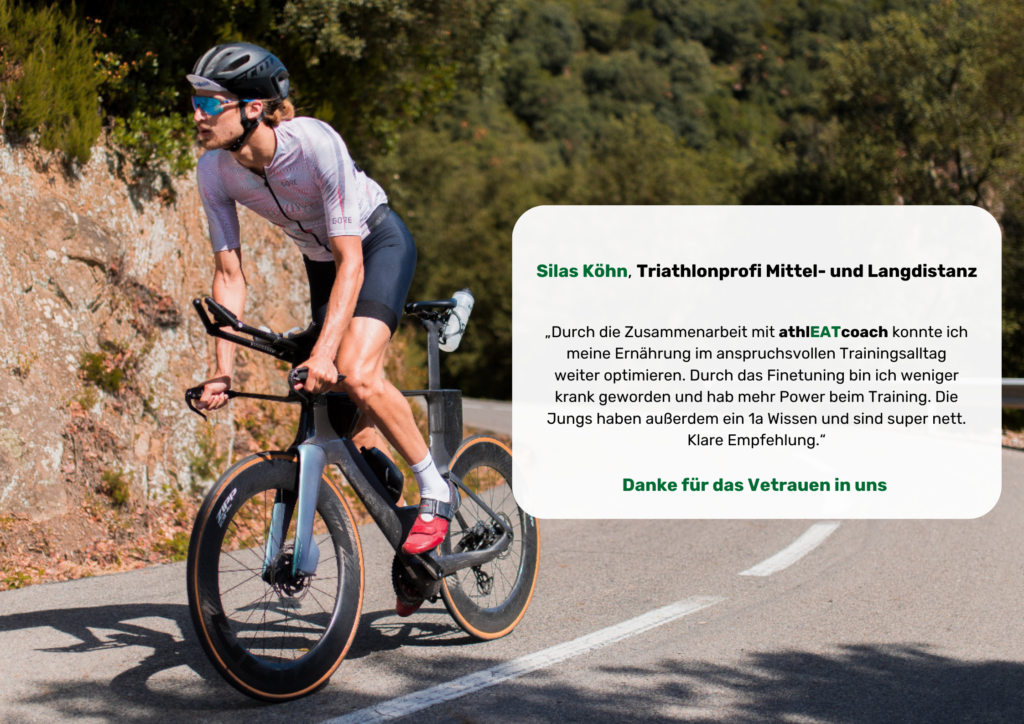
Would you like professional coaching? Then you can find more information about our coaching here. We offer a free info call to all interested parties.

